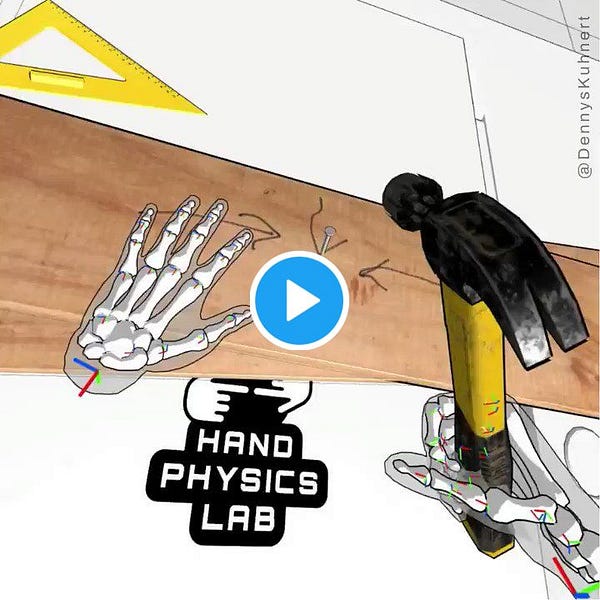Elon Musk's plan to save humanity by merging with machines
What happened on Tech Twitter August 23 - 30

Yo! ✌️ I’m Brett! I am a Product Manager and former Cognitive Science researcher. Social Studies is a semi-weekly newsletter for people building great products for humans. It includes recaps of what happened on Tech Twitter every week plus deep analysis using frameworks from Psychology, Economics, and the other Social Sciences.
🚨 Help me make Social Studies even better! Please fill out this quick survey for a chance to win a $25 Amazon gift card!
🚨 I apologize for the delay here. This email was supposed to go out on Wednesday but somehow didn’t. Substack support wasn’t super helpful either so I just decided to resend.
✨ TLDR
🦾 Elon Musk demoed his brain computer interface - omg it’s so dope!!
🔑 Elon believes Neuralink will save humanity - “God-like” AI could inadvertently destroy humanity in pursuit of even the most mundane objectives and the only way to stop it is to… become it.
🤖 We’ve already merged with machines - Brains and computers are just different computing devices we use with high latency between them.
🧠 Elon’s formula will make BCI widespread <30 years - He’s ignited the space industry with SpaceX, the electric car industry with Tesla, and is doing the same for brain computer interfaces with Neuralink.
🤯 The world will be unrecognizable - Elon says Neuralink could cure Parkinsons and allow you to stream music to your brain. It could also bifurcate humanity and enable a true hive mind.
🦾 Elon Musk demoed his brain computer interface
Neuralink is a brain computer interface company Elon Musk founded in 2016. It has mostly flown under the radar until just this last week when it held a public demo.
It was pretty damn ✨mind blowning✨



🔑 Elon believes Neuralink will save humanity
Elon Musk believes that “god-like” AI could inadvertently destroy humanity in pursuit of even the most mundane and benign objectives.
This idea is summed up with the concept of Instrumental Convergence:
An intelligent agent with unbounded but apparently harmless goals can act in surprisingly harmful ways
This is best understood with the Paperclip Maximizer problem, paraphrased from Less Wrong:
Imagine an AI whose goal is to maximize the number of paperclips in its collection.
If it has roughly human level intelligence, the AI might collect paperclips, earn money to buy paperclips, or begin to manufacture paperclips.
The AI would improve its intelligence, not because it values more intelligence, but because more intelligence would help it achieve its goal of accumulating paperclips.
Having increased its intelligence, it would produce more paperclips, and also use its enhanced abilities to further self-improve. Continuing this process, it would eventually reach god-like levels of intelligence.
At some point, it might turn Earth into a giant paperclip manufacturing facility, exterminating humans along the way since they’d be in the way of the AI making more paperclips.
Put more simply:
Ok so that seems like a real problem. If AI will destroy humanity, if it gets too powerful, shouldn’t we just stop building it?
Not so easy.
The law of accelerating returns says that technological progress is accelerating and uninhibited. Particularly when technology can be used to amass wealth or power, progress is a given. At this point, the cat’s out of the bag with AI and the arms race has begun. It’s not a matter of if, but when.
So AI is going to be powerful-enough in the (near) future to destroy humanity and progress can’t be stopped… We’re screwed?
Elon doesn’t think so.
The idea is simple - merge with AI and it can’t destroy us because we are it!
The idea of merging with machines may seem sci fi, but the reality is we already have.
🤖 We’ve already merged with machines
Elon Musk likes to say that we are merged with machines, but that there’s just super high latency. Compared to just remembering your friend’s phone number, tapping through your external silicone brain (iPhone) to find it takes a really long time.
I explained this a few weeks ago in a post about the implications of GPT-3 on the human identity:
Humans have been using tools to extend physical capabilities for millennia - rocks, swords, bicycles, etc. Studies have shown that the brain represents these tools as parts of the body.
Humans have also used tools to extend mental capabilities - currencies, writing, clocks, computers, and now AI. The brain also represents these tools as parts of the mind.
For example, the Getting Things Done productivity framework emphasizes writing tasks down so they don’t stay in your head. Here, writing is a means of transferring data from one storage device (your brain) to another (a note taking app). Once done, you can add new data to your brain.
Neuralink exists simply to reduce the latency between computers and humans.
🧠 Elon’s formula will make BCI widespread <30 years
Brain computer interfaces are not new. While there is a ton of new technology driving progress in the space, what’s actually new is Elon Musk himself.
As you may recall, the electric car and private space industries were basically stagnant until Elon Musk started Tesla and SpaceX. Now they’re booming.
Will the same thing happen for BCI? Yes.
How? There’s ✨a formula✨
Tim Urban documents Elon Musk’s company formula in his piece, Neuralink and the Brain’s Magical Future. Here’s a quick summary of the main points:
Elon wants to increase the chance of a good future for humanity
There are some big problems (sustainable energy, multi-planetary existence, and full BCI), that if solved, may do so.
It takes an entire industry to solve these problems, not just one company. We need all sorts of collaboration to make a Mars colony actually work, for example.
Industries need to be ignited through breakthroughs (e.g. lithium ion batteries in cars, reusable rockets) which can be made by one company
Lucrative near-term businesses (e.g. sports cars, delivering things to space) need to be built to fund R&D to reach these breakthroughs.
Here’s the formula for Tesla

And for SpaceX

And for Neuralink

As Tim Urban points out, the genius of Neuralink lies in its approach to solving the most crucial challenges that unlock mass adoption (implantation and bandwidth) while still building a sustainable business.
🔪 The Implantation Problem
Brain surgery is incredibly expensive, time consuming and invasive. The likelihood of normal people going in to get an BCI implant is dependent with each of these factors.
One of the key components of Neuralink is a surgery robot that will eventually be able to execute the entire surgery in a few minutes without the help of a doctor or general anesthetic and at the price-point of Lasik.
📶 The Bandwidth Problem
Decoding the brain such that it can be read and written to with a high-degree of accuracy is extremely important. You definitely don’t want to drop tables when it’s your actual memory on the line.
This can be solved by increasing the bandwidth or number of simultaneously recorded neurons. Biocompatible electrodes along with ML have driven meaningful progress towards the 1M recorded neuron goal and it will likely only continue.
💰 Neuralink’s near-term business
Like Tesla and SpaceX, Neuralink is building a lucrative business to fund solutions to the problems above.
In general, people with the strongest pain points and deepest pockets pay for innovation. For Neuralink, that’s people with severe cognitive and motor disorders like quadriplegia and Parkinson’s.
These disorders are so widespread and so ill-treated that there’s a huge business to be built if Neuralink successfully executes on its vision.
In fact, it already is. Neuralink received a breakthrough device designation from the FDA that will allow them to start clinical trials on people with tetraplegia and quadriplegia.
🤯 The world will be unrecognizable
Elon has stated in public events some really exciting realities Neuralink will enable:
Stream music (and any other audio) directly into your brain
Treatment for addiction, depression, autism, ALS, and OCD
Download your memories
Telepathically summon your self-driving Tesla and stream music
Here’s what others have been predicting:
📘 Learning will become instantaneous

🤯Digital experiences will be hyperrealistic. Instead of wearing haptic feedback gloves in VR, Neuralink can create experience the feeling of an object through direct sensorimotor cortex stimulation. Heck, the imagery itself could be streamed directly into your brain.
🧠The hive mind will emerge - A hive mind is defined by collective consciousness and action. A group of people that does the same things and thinks the same things. One could argue this already exists today (e.g. mob mentality, culture generally). Neuralink could make it even more real by allowing people to literally share memories.
👯♂️Humanity will bifurcate - Given how expensive Neuralink will be for some time, not everyone will be able to get it. This could exacerbate socioeconomic stratification or even bifurcate humanity as people with Neuralink massively outperform those who don’t over time.
💉 Dopamine Hits




📚 Long Reads







🙏 Thanks
Have a great week! I’m off to Tulum on Friday ✨












